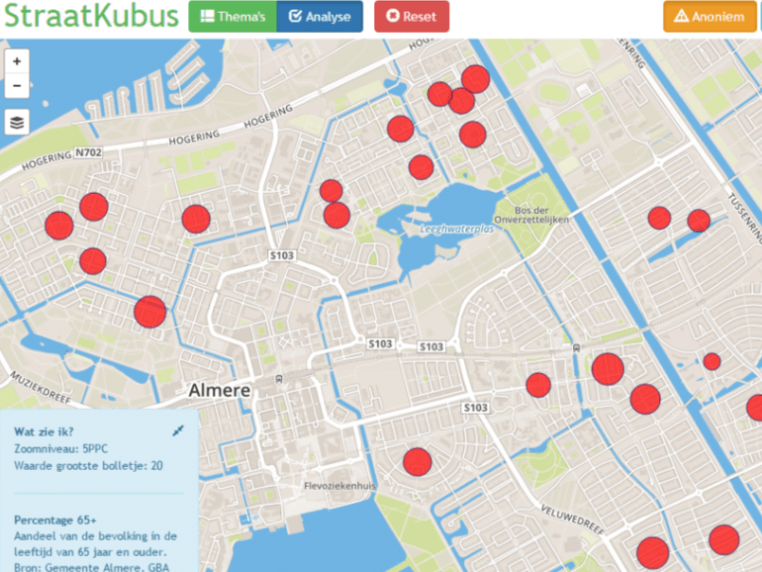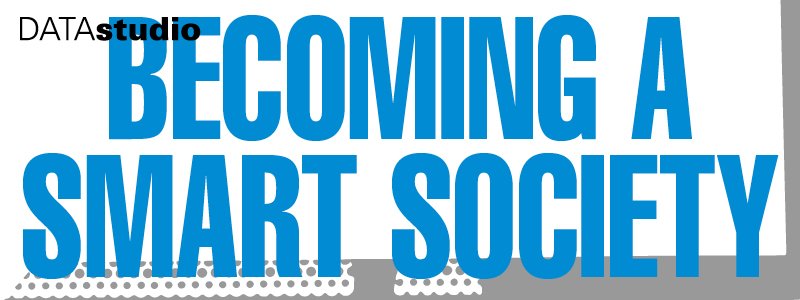
Eindhoven wants to become a smart society. But how does that work? What’s going on in a society like that? Are there any good examples to learn from? DataStudio Eindhoven explores the transition a city has to go through to actually become such a smart society. Each week, we present a new contribution on E52. This week: Street Cube. Read all the articles here.
In 1971, the Netherlands was in disarray. Why? Because of the Fourteenth General Census. The Central Bureau of Statistics wanted to collect more details than ever before. According to many, it was an invasion of their privacy. Why is it necessary for the government to know what my household is like, is what people wondered. The Census was done, nevertheless, and since then, it is common that demographic data is known by various authorities. However, the question from that time remains. In Almere, they have an answer: the Street Cube.
The Street Cube is a geographic information system that tries to summarize, in numbers, the livability of various neighborhoods. “It looks like a kind of Google Maps with a lot of filters”, explains Paul Mulder. The researcher from Almere Council is responsible for gathering, filtering, and deciphering the data.
The data comes mainly from existing sources, says Mulder. “It is a combination of basic registrations about demography, type of housing, type of household, and ethnicity.” This information is complemented with data from housing corporations and police. “For example, details about burglaries and other grievances. A lot of data is also available from the CBS.” In addition to this free information, the council has purchased another set of data from the company Whooz, where information about, for example, education levels, are included.
The result is an extensive catalogue of various facts, classified in a long list of topics. Separate, the sets are of relative value. The crux of the cube lies in combining the data. This creates the possibility of the early detection of problems.
For example, the project Behind the Front Door originated with the help of the Street Cube. In this project, Almere Council endeavors to detect debt situations early, and can then intervene to deter this. Community workers suspected problems in certain families in the city, but they could not substantiate this ‘gut feeling’. As various social agencies looked through the data, the suspicion of debt problems arose. After conducting personal interviews in the area, this suspicion proved correct.
And so, a concrete result. Achieved through the use of data, with help from the Street Cube. A name which does not refer to a real street, mentions Mulder. “Because of the overlay of different sets of data, a three-dimensional picture of demographic detail emerges. Hence, the name Street Cube.”
So it is not only authorities and individuals in Eindhoven who are scrambling to shape the Smart City, or even a Smart Society. Elsewhere in the country they are also working hard on smart solutions with Big Data. Besides Almere, Dordrecht, Hengelo, and Purmerend are also involved in the development of the Street Cube.
Perhaps interesting for our city. However, the standard question that always looms with Big Data also comes into question here. What about privacy?
That is also taken into consideration, according to Mulder. “The Street Cube is only available to a limited number of people. We have set up a special coordinating role. This person determines whether requests for access are justified or not.” Furthermore, it is not possible to retrieve data on a personal level: “With the application, you can zoom in until a six digit postcode level. On average, that is a group of 40 people.”
A world of difference from 1971, when the census collectors went from door to door with pens and paper. It would prove to be the last census. Ever since, the CBS has used the Municipal Administration to obtain information, supplemented with samples and surveys. It is perhaps disturbing to know that your data is recorded somewhere. But a number of debt-free households in Almere are grateful.
Want to read more
https://www.movisie.nl/praktijkvoorbeeld/straatkubus
http://magazine.kinggemeenten.nl/data-en-gemeenten#!/1-amsterdam-copy-7
http://www.bdvc.nl/overheid/200-we-cre%C3%ABren-veiligere-buurten-voor-iedereen.html
http://anderetijden.nl/aflevering/156/De-burger-in-kaart
http://businesscases.effectieveschuldhulp.nl/?page_id=20


